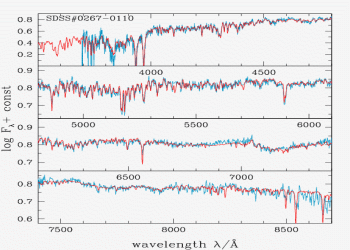 |
|
Fig. 2: Reproduction of the same SDSS spectrum as in Figure 1 (in blue)
by the new, high-resolution (
 ) population
synthesis model developed at the MPA (in red). The main stellar absorption
features in the observed spectrum are now well reproduced by the model. The
requirement to fit these features leads to valuable constraints on the stellar
content of the observed galaxy (see text). ) population
synthesis model developed at the MPA (in red). The main stellar absorption
features in the observed spectrum are now well reproduced by the model. The
requirement to fit these features leads to valuable constraints on the stellar
content of the observed galaxy (see text).
|
|
|  |
The star formation and chemical enrichment histories of the Universe are
imprinted in the light emitted from galaxies. The integrated light of a galaxy
is the sum of the emission from stars of various ages that were born at
different cosmic epochs. Stars of a given age have the chemical composition of
the gas out of which they formed, and the light they emit contains information
about both their age and their chemical composition. If we can interpret the
spectra of nearby galaxies in terms of the different stellar generations that
compose them, we will be able to reconstruct the star formation and chemical
enrichment histories of the Universe.
Stellar population synthesis, the modeling of the spectra emitted by
specific populations of stars, is a natural approach to interpreting observed
galaxy spectra. This technique combines stellar evolution theory with a
library of individual stellar spectra that describe the emission from
stars of any mass, age and metallicity. Current population synthesis models,
however, suffer from a serious limitation: their spectral resolution is
typically much lower than achieved in modern spectroscopic galaxy surveys.
Figure 1 illustrates how current models compare to the high-quality spectra
obtained by the Sloan Digital Sky Survey
( SDSS),
which the MPA joint as a Participating Institution in January 2001 (see SDSS),
which the MPA joint as a Participating Institution in January 2001 (see
 highlight of April 2002).
It is clear from this figure that the model resolution is far too low
to help us decrypt the plethora of absorption lines in the observed spectrum.
These lines are produced by atomic and molecular transitions in the stellar
atmospheres, and they contain valuable information about the ages and the
metallicities of the stars making up the galaxy's light. highlight of April 2002).
It is clear from this figure that the model resolution is far too low
to help us decrypt the plethora of absorption lines in the observed spectrum.
These lines are produced by atomic and molecular transitions in the stellar
atmospheres, and they contain valuable information about the ages and the
metallicities of the stars making up the galaxy's light.
G. Bruzual (Center for Astronomical Research, Mérida, Venezuela and MPA) and
S. Charlot (MPA) have developed a new population synthesis model enabling
the interpretation of high-resolution galaxy spectra. This model incorporates
the most recent developments in stellar evolution theory and a
 new library
of high-resolution,
individual stellar spectra. Figure 2 shows how this model compares to the same
observed SDSS spectrum as in Figure 1. The main stellar absorption features in
the data are now well reproduced by the model. The requirement to fit these
features leads to valuable constraints on the stellar content of the observed
galaxy. In the example shown, 80% of the total stellar mass of new library
of high-resolution,
individual stellar spectra. Figure 2 shows how this model compares to the same
observed SDSS spectrum as in Figure 1. The main stellar absorption features in
the data are now well reproduced by the model. The requirement to fit these
features leads to valuable constraints on the stellar content of the observed
galaxy. In the example shown, 80% of the total stellar mass of
 solar masses can be attributed to stars of slightly sub-solar
metallicity formed 5-13 Gyr ago, 16% to stars of slightly supra-solar
metallicity formed 2.5-5 Gyr ago, and the remaining 4% to stars of
supra-solar metallicity formed 1.0-2.5 Gyr ago. solar masses can be attributed to stars of slightly sub-solar
metallicity formed 5-13 Gyr ago, 16% to stars of slightly supra-solar
metallicity formed 2.5-5 Gyr ago, and the remaining 4% to stars of
supra-solar metallicity formed 1.0-2.5 Gyr ago.
The SDSS will obtain spectra of the type shown in Figure 2 for nearly a million
nearby galaxies. Using the above model to constrain the stellar content of the
galaxies, it will be possible address key cosmological questions, such as
when did stars in the Universe form, whether star formation occurs continuously
or in bursts, whether galaxies hold onto the heavy elements they produce or
eject a substantial fraction, how the masses of galaxies evolve with time, and
how their ages and star formation histories depend on luminosity, morphological
type and environment.
Stephane Charlot
|